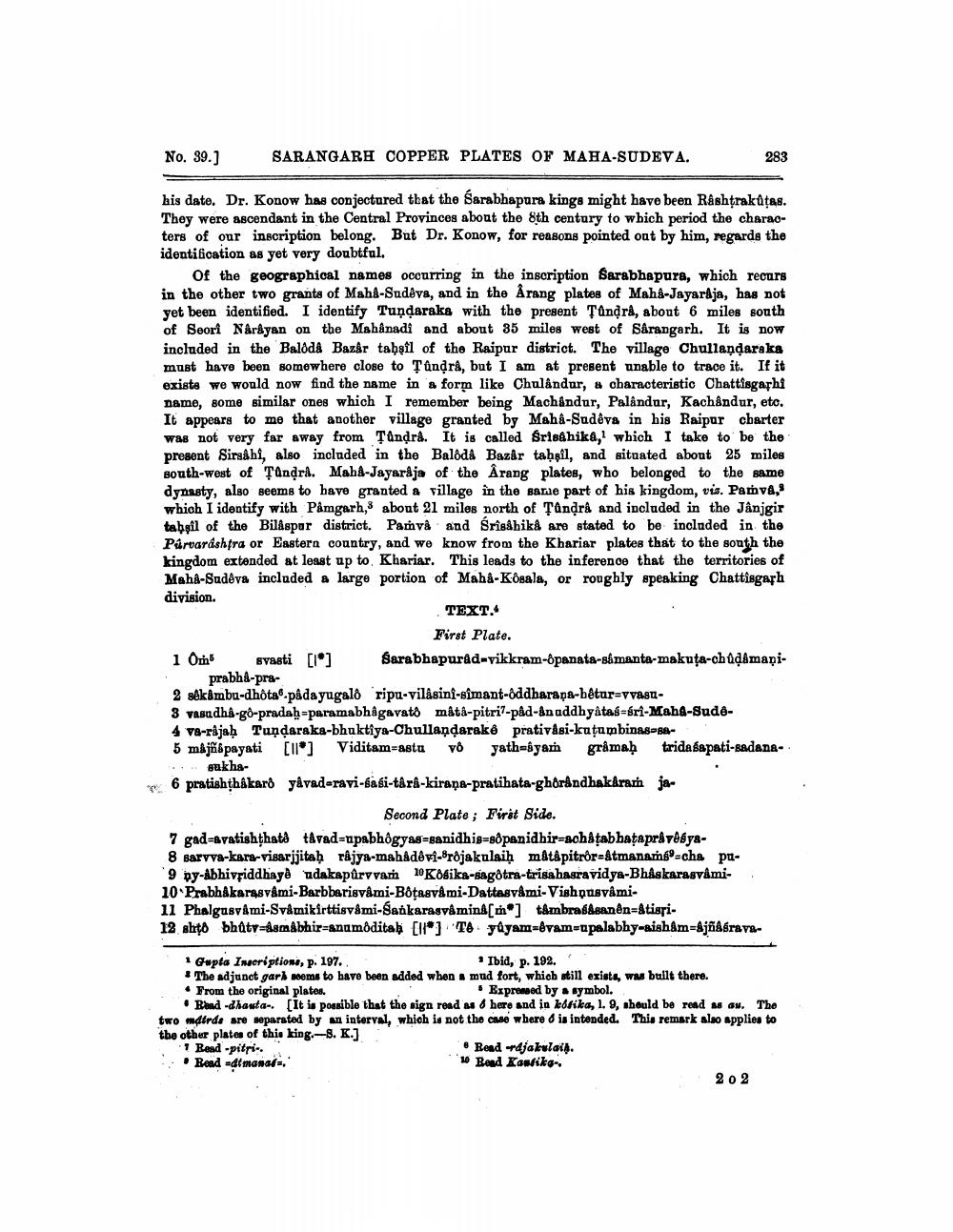________________
No. 39.]
SARANGARH COPPER PLATES OF MAHA-SUDEVA.
283
his date. Dr. Konow has conjectured that the Sarabhapura kings might have been Rashtraktas. They were ascendant in the Central Provinces about the 8th century to which period the charaoters of our inscription belong. But Dr. Konow, for reasons pointed out by him, regards the identification as yet very doubtful.
of the geographical names occurring in the inscription Sarabhapura, which recurs in the other two grants of Mahd-Sudéva, and in the Arang plates of Maha-Jayaraja, has not yet been identified. I identify Tuņdaraks with the present Tandra, about 6 miles south of Seori Nåreyan on the Mahånadi and about 35 miles west of Sarangarh. It is now included in the Baloda Bazar tahşil of the Raipur district. The village Chullandaraka must have been somewhere close to Tanara, but I am at present unable to trace it. If it exists we would now find the name in a form like Chulândur, #characteristic Chattisgashi name, some similar ones which I remember being Machåndur, Palândur, Kachåndur, etc. It appears to me that another village granted by Maha-Sudêva in bis Raipur charter was not very far away from Tandrå. It is called Srisâhika, which I take to be the present Sirsahi, also included in the Baloda Bazar tabpil, and situated about 25 miles south-west of Tandra. Mah-Jayaraja of the Arang plates, who belonged to the same dynasty, also seems to have granted a village in the same part of his kingdom, vis. Parve, which I identify with Påmgarh, about 21 miles north of Tandra and included in the Janjgir tahsil of the Bilaspur district. Paṁvå and Srigåhika are stated to be included in the Pärvarashtra or Eastern country, and we know from the Khariar plates that to the south the kingdom extended at least up to, Khariar. This leads to the inference that the territories of Mahd-Sudeva included a large portion of Mahå-Kobala, or roughly speaking Chattisgarh division.
TEXT.
First Plate. 1 Om svasti [1] Sarabhapurad-vikkram-panata-samanta-makuța-chudamani
prabhå-pra2 sekāmbu-dhôta-pådayugalo ripu-vilasini-sîmant-8ddbarapa-betur=vvast3 vasudha-go-pradah-paramabhagavató máta-pitri-pad-&naddhyâtas-sri-Mahd-Sudê4 va-rijah Tundaraka-bhuktiya-Chullaņdaraké prativasi-kutumbinas-- 5 májõ&payati [ll*] Viditam=asta VÔ yath=syam gråmaḥ tridagapati-sadana
sukha6 pratishthákarð yâvad=ravi-basi-tåra-kirana-pratihata-ghörandhakarar ja
Second Plate ; First Side. 7 gad=syatishtható távad=upabhôgyas=sanidhis=spanidhir=sch&tab hataprévébya8 Barvva-kara-visarjjitaḥ rajya-mahadewi-Srôjakulaiḥ matapitrôr=&tmanargo-cha pu'9 py-abhivriddhayd udakapūrvvam 10 Koliks-sagðtra-trisahasravidya-Bhaskarasvåmi10 Prabhákarasvåmi-Barbbarisvåmi-Bôțasvami-Dattasvami-Vishnusvåmi11 Phalgusvâmi-Svåmikirttisvšmi-Sankarasvåmina[mo] tâmbragdsanên=&tissi. 12 shto bhůty=AsmAbhir=anamõditabi [ll] TO yam=evam=apalabhy-sish&m=&jñaśrava
1 Gupta Inscriptions, p. 197..
Ibid, p. 192. * The adjunct garl sems to have been added when a mud fort, which still existe, was built there. • From the original plates.
- Expressed by a symbol. • Band -dhauta-. (It is possible that the sign read as 8 here and in kolika, 1. 9, should be read as dw. The two mdirds are separated by an interval, which is not the case where & is intended. This remark also applies to the other plates of this king.-8. K.] Read -pitri.
Read djakulais. Read -demanar
10 Bead Kasfiks
202




